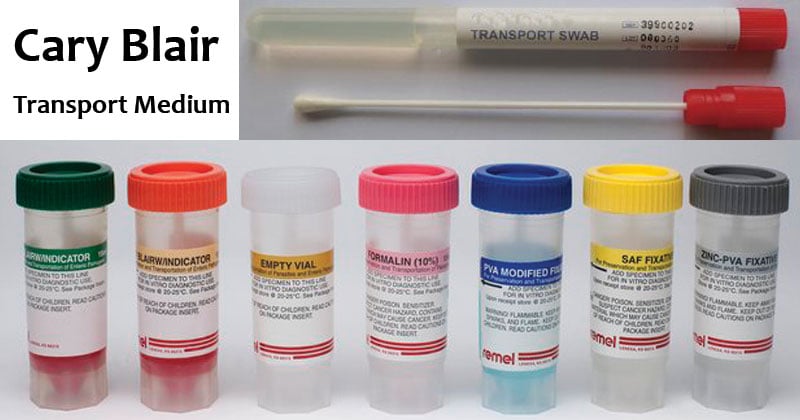Cary-Blair Transport Medium is a simple, semi-solid, non-nutritive medium used for the collection and preservation of microbiological specimens. The minimal nutrients in the medium facilitate the survival of organisms without multiplication. The semisolid consistency provides ease of transport, and the prepared medium can be stored for up to 1 year after preparation at room temperature. Cary-Blair Transport Medium is a modification of Stuart’s Medium which is comprised of an improved buffering system by replacing sodium glycerophosphate with inorganic phosphates. This improved formulation prevents the overgrowth of Enterobacteriaceae and contributes to the effective preservation of Salmonella and Shigella for long periods. It is used for the transportation of clinical specimens suspected to contain enteric pathogens, including Shigella, Salmonella, Vibrio cholerae, and Escherichia coli O157: H7.

Interesting Science Videos
Composition of Cary Blair Transport Medium
| Ingredients | gm/litre |
| Disodium hydrogen phosphate | 1.1 |
| Sodium thioglycollate | 1.5 |
| Sodium chloride | 5.0 |
| Calcium chloride | 0.1 |
| Agar | 5.0 |
| pH | 8.4 ± 0.2 @ 25°C |
Principle of Cary Blair Transport Medium
Cary-Blair Transport medium semi-solid medium with minimal nutrients. The sodium chloride and calcium chloride levels in the medium aid in controlling cell permeability and provide an osmotic balance environment for the preservation of viable bacterial cells. Sodium thioglycollate provides a low oxidation-reduction potential. In addition, disodium hydrogen phosphate helps maintain a stable pH and prevents pH fluxes that may be detrimental to the organisms present in clinical specimens. Alkaline pH of the medium minimizes bacterial destruction due to the formation of acid. Since this transport medium has a high pH (8.4), the viability of Vibrio cultures can be maintained for a longer duration and it is considered as the medium of choice for transport and preservation of Vibrio cholerae.
Preparation of Cary Blair Transport Medium
- Suspend 13.3 gm in 1 liter of distilled water and bring gently to the boil to dissolve the agar.
- Dispense the medium in 7ml amounts in screw-cap bottles of 9 ml capacity (large size Bijou bottles).
- Sterilize by steaming with caps loosened (do not autoclave) at 100°C for 15 minutes.
- Allow to cool and tighten the screw caps to prevent water loss and label the bottles.
- Store in a cool dark place with the bottle tops screwed tightly.
Appearance of Cary Blair Transport Medium
Dehydrated medium: Off-white color, free-flowing powder
Prepared medium: Light amber color, semi-solid gel
Quality Control
Positive controls |
Expected results |
| Shigella flexneri ATCC 12022 | Good growth on subculture |
| Salmonella Typhimurium ATCC 14028 | Good growth on subculture |
Negative control | |
| Uninoculated medium | No change |
Uses
- It is recommended for use in the transportation and preservation of the clinical specimens primarily stool and rectal swabs.
- It is used to transport enteric pathogens, including Shigella, Salmonella, Vibrio cholerae, and Escherichia coli O157:H7.
Limitations
- It is only intended for transport purposes, therefore, lengthy delays in transport or processing of specimens may result in diminished viability of bacterial cells and allow, to some degree, contaminating flora to replicate in the medium. Therefore quick transport of the specimen is essential for accurate and conclusive laboratory results.
- Prompt plating, refrigeration, or freezing of specimens in the Cary-Blair medium is particularly important for the isolation of Shigella which is comparatively more fragile than other enteric organisms.
- Cary-Blair Transport Medium is sensitive to extreme heat, therefore, the medium has not been autoclaved; therefore the sterility of this product is tested but not absolute.
- Specimens collected after initiation of antibiotic therapy may be contradicted for the successful recovery of the enteric pathogens.
References
- Cheesbrough M., District Laboratory Practice in Tropical Countries: Part 2:.Cambridge University Press.
- Ronald M. Atlas and James W. Snyder (2014). Handbook of media for clinical and public health microbiology. CRC Press. Taylor & Francis Group, LLC
- Thermo fisher
- http://www.oxoid.com/UK/blue/prod_detail/prod_detail.asp?pr=CM0519&c=UK&lang=EN
- Himedia
- http://www.dalynn.com/dyn/ck_assets/files/tech/TC35.pdf
- http://tools.thermofisher.com/content/sfs/manuals/IFU60450.pdf
